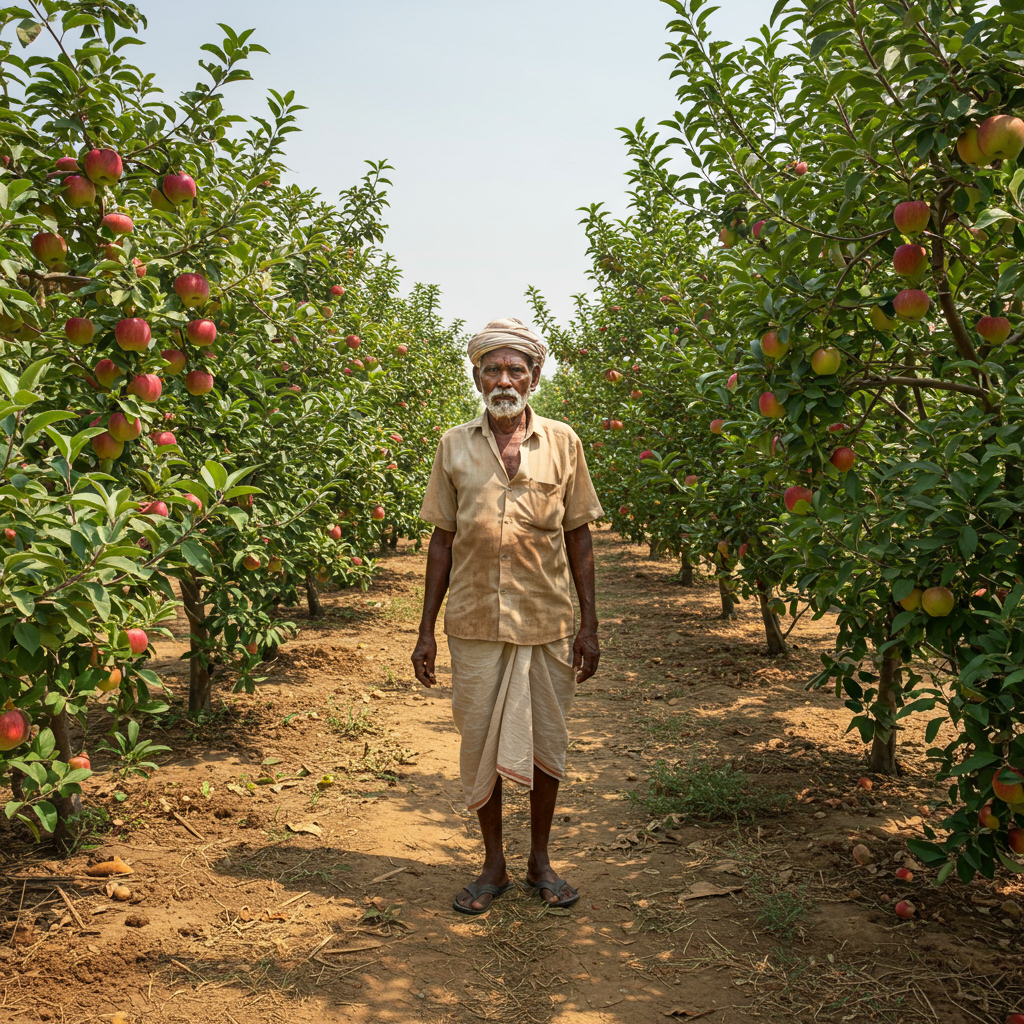Growing apples might seem like a straightforward agricultural pursuit, but for farmers like Kakasaheb Sawant in subtropical southern India, it was met with disbelief from his neighbours. “My neighbours thought I’d lost my mind,” he recounts. Unlike the cool climates typically associated with apple orchards, Mr. Sawant lives in a region where temperatures can soar to 43°C.
Yet, in 2022, he took a leap of faith, planting 100 apple saplings. Remarkably, 80 survived, and by the following year, each tree was yielding between 30 and 40 kilogrammes of fruit. His farm has since become a local sensation, drawing visitors eager to witness apple trees thriving under the intense Maharashtra sun.
However, this ‘miracle’ isn’t without hurdles. The apples aren’t currently sweet enough for commercial sale. Despite this, Mr. Sawant remains hopeful, successfully selling saplings and anticipating sweeter harvests in the future as the trees acclimatise. He optimistically predicts that in four to five years, his trees will produce commercially viable fruit.
India’s Growing Apple Appetite vs. Stagnant Production
Mr. Sawant’s efforts, though small scale for now, point to a larger national challenge: meeting India’s rapidly increasing demand for apples. While domestic production has grown by 15% over the last five years to 2.5 million tonnes, this hasn’t kept pace with consumption. Consequently, India’s apple imports have roughly doubled to 600,000 tonnes during the same period, highlighting a significant shortfall.
According to analyst S Chandrashekhar, the industry faces a lack of new entrants and insufficient investment, contributing to the production gap.
Challenges in Traditional Apple Belts
A key factor for successful apple cultivation is a specific cold requirement – a lengthy period of ‘chilling hours’ between 0°C and 6°C. Countries like the UK offer around 1,000 hours of this chill, suitable for almost any apple variety. In India, areas with these conditions are primarily limited to the northern regions of Jammu and Kashmir and neighbouring Himachal Pradesh, which supply the majority of the country’s apples.
However, these traditional apple-growing regions are grappling with their own set of problems. Many orchards are aging, leading to declining yields. Adding to the pressure, climate change is wreaking havoc, reducing the crucial chilling hours and causing erratic weather patterns that result in substantial financial losses for farmers. Some growers in these areas are attempting to adapt by moving their orchards to higher altitudes that were previously considered too cold.
Exploring Low-Chill Varieties in Warmer Climates
In response to the challenges in traditional areas and the need to expand production, scientists and farmers are looking south, experimenting with apple varieties known as ‘low-chill’. These trees require significantly fewer chilling hours – around 400 hours between 0°C and 6°C – potentially making them viable in warmer, subtropical regions.
In Ranchi, eastern India, another subtropical area, researchers at Birsa Agricultural University (BAU) are testing 18 saplings from three different low-chill varieties. Progress has been slow; only one variety has produced fruit so far, with yields of only one to two kilogrammes per tree in 2024. Dr. Majid Ali attributes these limited results not only to the challenging climate but also to unsuitable local soil and vulnerability to termite attacks. He stresses that this is an experimental phase, requiring another three to four years to draw firm conclusions about commercial viability. Local farmers experimenting independently have also reported little success.
Skepticism and the Focus on Breeding
There is considerable skepticism regarding the potential for apples grown in non-traditional, hot regions to become commercially successful. Dr. Dinesh Thakur, based in Himachal Pradesh and focused on apple improvement through breeding, points out that fruit from these areas often suffers from a short shelf life and insufficient sweetness. He views low-chill apples in hot climates as suitable for novelty in kitchen gardens but unproven and largely a “failure” as a commercial crop.
Dr. Thakur’s own research team at Dr. YS Parmar University is concentrating on developing apples better suited to the changing climate within traditional regions. Under a government project, they are evaluating 300 varieties and working on creating climate-resilient genotypes. They have successfully developed a variety that ripens two months earlier, helping farmers navigate unpredictable weather and improving fruit colour, which can be challenging due to insufficient sunlight in some areas. This breeding work aims to produce climate-resilient fruit acceptable to the Indian palate.
Beyond Science: The Need for Investment
Boosting India’s overall apple production requires more than just scientific breakthroughs in breeding or adapting to new climates. S Chandrashekhar highlights the critical need for replanting aging orchards in traditional areas. He stresses that the industry requires “huge investment,” posing the question of who will provide it. He also suggests developing the apple juice and jam processing industry as another revenue stream, which could significantly improve the economic position of apple growers and boost the overall apple economy.
The quest for the perfect apple in India is a multi-faceted challenge, tackled from different angles – from brave farmers trying new regions to scientists breeding resilient varieties. It’s a complex endeavour driven by national demand and complicated by the undeniable impacts of a warming climate. While success is far from guaranteed in all areas, these ongoing experiments represent the beginning of India’s journey to secure its apple future.




